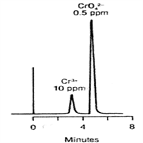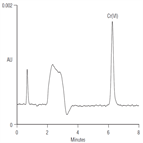Find methods for your needs
Refine by Feature
Displaying 1-3 of 3 results for Tag: industrial waste water
TN24: Determination of Chromium by Ion Chromatography
Instrument Type: ICThree methods are presented here for the determination of Chromium in various matrices. Method A utilizes a postcolumn reaction (PCR) with a color reagent. It is a very selective and sensitive method, allowing determination of Cr(III) & Cr(VI) at ppb levels. Method B also utilizes a PCR, but determines Cr (VI) only. It is used for industrial waste waters, analyzing samples that have undergone standard oxidation. Method C allows the determination of inorganic anions in addition to chromate by chemically suppressed conductivity. Please refer to AN1116, AU144, AU165 and AU179 for updated methods.
AU144: Determination of Hexavalent Chromium in Drinking Water Using Ion Chromatography.
Instrument Type: ICHexavalent chromium, Cr(VI), is the most toxic form of chromium, a primary drinking water contaminant in the U.S. Cr(VI) can be determined as chromate by ion chromatography in drinking water, and wastewater.The California Department of Health Services recently issued a new Public Health Goal of 0.2 µg/L for Cr(VI). EPA Method 218.6 does not allow sufficient sensitivity for analysis at the California PHG level. This update describes modifications to Method 218.6 that significantly increase sensitivity over the existing method.Also refer to AU 179 for an updated method.
AN80: Determination of Dissolved Hexavalent Chromium in Drinking Water, Groundwater and Industrial Wastewater Effluents by Ion Chromatography.
Instrument Type: ICChromium exists in the environment in either the trivalent, Cr(III), or hexavalent, Cr(VI), form. The method presented here provides a sensitive and selective means of determining Cr(VI) as the chromate anion CrO4^2- down to the 1 μg/L level in a variety of environmental matrices. It has been validated over the range of 1–1000 μg/L in both wastewater and drinking water with a method detection limit in the range of 1 μg/L. Also refer to the AU144 and AU179. These application updates describe modifications that significantly increase sensitivity over the existing method.



